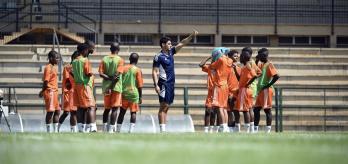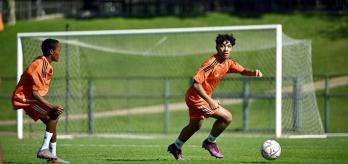Methodology
The intention: What is practised?
The objective of this exercise is to enhance a unit’s ability to effectively secure possession within a narrow focus. There are other aspects, such as creating and finishing, that do not feature in this particular exercise. The drill emphasises unit actions, with players tasked with working on the unit’s shape in possession with a view to enabling them to retain possession in congested areas. Transitions are a frequent feature of the exercise, and the unit is encouraged to widen the exercise area as soon as they win the ball so as to provide the ball carrier with multiple passing options, including short options, inside options and deep options to ensure that there is good structure to their passing. When out of possession, the unit must reduce the distances between themselves and shut off the opposition’s passes through central areas.
The scale: For whom is this relevant?
The drill revolves around the unit, with a focus on its shape in and out of possession. The exercise is non-position-specific, as the positions occupied by players bear very little relationship to the players’ positioning and role. The game is particularly relevant for a scenario in which a unit seeks to regain its passing shape around an opposing team’s press in an attacking transition. Meanwhile, the exercise also applies to a unit in a defensive transition in which the players are tasked with reducing the distances between themselves and organising second- and third-man pressing actions to avoid being played through. In addition to unit skills, individual skills, including adopting an open body shape and recognising space to move into, are crucial in this exercise.
The practice type: How is the practice designed?
The drill involves an opposed possession game, featuring variable repetitions that provide plenty of opportunities for a unit to practise offering passing options, the movement to receive and playing through. The two neutral players positioned at opposite ends of the exercise area operate as a target to provide the unit with a direction of play, whilst the two neutral players who operate inside the exercise area must occupy positions in the middle of the field to ensure that an inside passing option is always available. A constraint is in place that means that players have to pass the ball inside, which serves to develop the unit’s ability to play through the opposition’s press and congested areas. For the players positioned inside the exercise area, the drill is non-position-specific, with all players rotating positions and exposed to the same tasks.
Session plan
Organisation
-
Mark out a 20x20m exercise area.
-
Split the group into 3 teams of 4.
-
Set up a 4v4 inside the exercise area (greens v. blues).
-
The orange team are neutral: place 2 orange players inside the exercise area and the other 2 orange players at either end of the exercise area.
Explanation
-
The exercise starts with one of the orange players positioned at either end of the exercise area in possession.
-
The blue team’s objective is to progress the ball from one of the outside orange players to the other.
-
Passes cannot be played from an outside orange player to an inside player occupying a wide position, then to the opposite outside orange player. Passes must be played into the centre of the exercise area before being played to an outside orange player.
-
The green team press and try to regain possession. If they manage to do so, they then become the in-possession team.
-
The in-possession team can use the 2 orange players positioned inside the exercise area.
Key coaching points
Roles of coaches
-
First coach: leads the exercise by providing in-possession players with a number of options and solutions to play out of pressure.
-
Second coach: offers instructions and encouragement from their position on the opposite side of the exercise area to the first coach.
-
Third coach: feeds balls into the exercise area and offers players encouragement.















